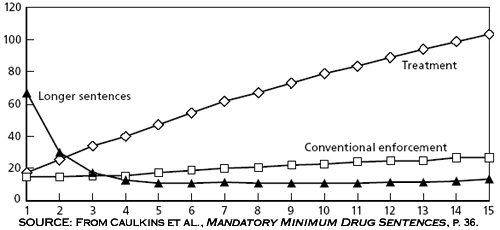March 30, 2005
| Just for Tim >>
Even More Scenes from the Drug War
The RAND Corporation has released a report taking a comprehensive look at the effectiveness of US anti-drug policies. Asking, specifically, “Why do they suck so much?”
Short answer? ‘Cause we mostly apply one solution — incarceration — to a thousand different problems. But that’s not news. Here’s some stuff the RAND study points out that struck me as enlightening. (I’ve also gotta plug the Mark A. R. Kleiman book Against Excess, available in its entirety online. It was prominently cited in the RAND study, so I searched for it, and there it was.)
Point: Broadly, you can track the inherent problem of people abusing drugs using two metrics: 1) how many people are using drugs? 2) how heavily are people using drugs?
Our drug policy really only concerns itself with 1. If we’ve got fewer drug abusers on the street, we think we’re winning. But the greater social problems that arise out of drug abuse generally come from a small group of heavy drug users.
Point: We’ve got three overarching policy methods for attacking drug abuse — 1) treatment, 2) enforcement, and 3) prevention. Our policy is heavily weighted towards enforcement (53% of the 2003 federal anti-drug budget was devoted to enforcement, 29% to treatment, and 18% to prevention). But look at this graph:

This shows what happens when you pour a million dollars into each of three different drug control methods. It shows how many kilos of cocaine are taken off the street over the first fifteen years.
One of the most politically popular enforcement tactics — giving drug dealers and users longer prison sentences — has severely diminishing returns. For the first year, we’ve taken a dealer off the street, but by a couple years later, the drug market’s found a replacement.
Plus, mandatory minimums are usually based on quantities of drug possession at the time of arrest. High-level dealers generally don’t carry all that much junk around with them. So you’re putting away, in essence, the middle men.
Treatment, on the other hand, is the gift that keeps on giving.
Point: Different drugs get born into a society at different times, but we pretty much employ the same strategy to combat all drug use at all times.
Right now, for example, meth is just beginning to take off; it’s not yet a nationwide epidemic. To stop this particular drug epidemic from spreading too far too quickly, we could apply a short-term strategy of heavy enforcement, before it takes off. Then we could switch to a more treatment-heavy approach when the drug’s popularity stabilizes.
Cocaine is a drug whose popularity has already stabilized, so our policy now should target treatment — getting the drug off the street for the long term.
Point: Different cities and states should be applying different strategies for dealing with drugs. But our drug policy right now is pretty homogenous everywhere, and the feds only exacerbate this (by, for example, fighting states’ efforts to experiment with medicinal marijuana).
At the same time, the “War on Drugs” is surprisingly decentralized. Our “drug czar” controls only a small fraction of drug policy in the US. So when we do want to implement broadly coordinated strategies (like, say, discouraging mandatory minimum sentencing), we really can’t, unless the idea becomes popular amongst federal legislators.
Point: Research and development is cheap and effective. But lawmakers are much more likely to call for studies on prevention and treatment than they are for studies on enforcement. (When we’re being “tough on crime,” we don’t need no stinkin’ studies.)
Point: Even though our current drug policy is universally unpopular, many mechanisms conspire to keep legislators fighting the same old fight.
Proposing mandatory minimum sentences, for example, although it makes no sense from a utilitarian standpoint, is a superficially low-cost, high-return investment of political capital for a legislator. After all, you don’t have to add anything to your current budget when you say, “We’re going to put these dealers away for 25 years!”
But the cost to treat a drug abuser basically all falls within the first year, so it looks like a big ol’ immediate expense. And people generally feel squicky about spending all kinds of money on convicts and not just punishing them with it.
Conclusion: It’s an excellent study, readable and worth it, if you’re interested in a quick primer on what’s been done in the war on drugs and what should be done. I’ve given headlines here, but the study, of course, goes into much more nuance.


